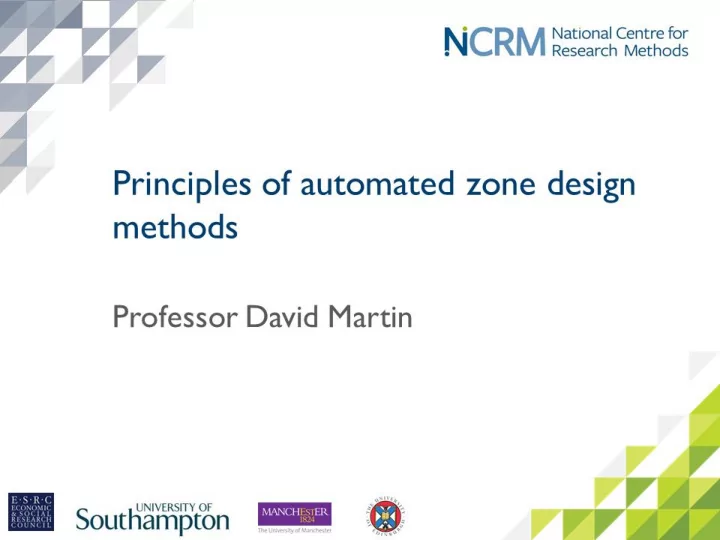

Second video - principles of automated zone design methods
Principles • Need to achieve a set of zones that meet specific design criteria (e.g. not too big, not too small, sensible shapes, similar populations) • Always a trade-off between competing objectives • Natural human inclination to draw lines on a map into order to subdivide a larger area • Alternative approach to put together many small areas as if completing a jigsaw - most computational approaches are closer to this
Automated Zoning Procedure (Openshaw, 1977) • Initial random aggregation of building blocks into groups (here called “tracts”) • Compute statistics (shape, size, etc.) • Swap building blocks between tracts • If solution improved, keep the swap • Try swapping another building block • Try another starting aggregation • Simulated annealing, tabu searching, etc. refinements to avoid local suboptima
Automated zone design • Iterative re-combination of input building blocks to create output tracts which optimise pre-specified design criteria Possible Solutions Building Tracts blocks “Best” solution
Building blocks • Building block zones may come from many different sources (purpose-built or pre-existing) • Need to be small relative to the output zones • Most will be generated using a geographical information system (GIS) • Statistical information to evaluate the design criteria needed for each building block • May require use of confidential data in order to design zones for which data can be published
Address polygon generation Use GIS to generate Thiessen (Voroni) polygons around each address location
Postcode polygon creation Dissolve boundaries between address polygons having common postcodes
Building block considerations • Big impact on zone design solution • Output zone boundaries drawn from building block boundaries: cannot be smoother, more realistic or better-aligned to real-world features • As number of building blocks increases: more permutations, longer computation times and (probably) more good solutions
Zone design criteria • Hard constraints – must be met • e.g. more than 100 people and 40 households • e.g. must not cross local authority boundary • Soft constraints – cannot be met exactly, but should be treated as objectives • e.g. zones should contain 125 households • e.g. zone should be as compact in shape as possible
Design criteria - measurement • Suitable statistical measures that can be repeatedly recalculated for each of the design criteria • e.g. disallow any zone with a population less than threshold value • e.g. solve for all building blocks within an external boundary • e.g. minimize sum of {squared differences from target population size} • e.g. minimize sum of {perimeter squared/area}
Automated OA design Initial Random Aggregation of Building Blocks Design Constraints Iterative Recombination (Contiguity, Thresholds, Shape, Size, Homogeneity) Output Areas
How does it work? Initial random aggregation of building blocks into potential tracts
How does it work? Choose one building block at random as candidate for swapping into a different tract
How does it work? Make the swap and evaluate the impact on the overall solution
How does it work? If swap does not result in an improvement, go back to the previous configuration
How does it work? Choose another building block at random as candidate for swapping into another tract
How does it work? If the swap results in an overall improvement, keep it as part of the solution and examine a new potential swap…
Summary • All data for evaluation need to be available at the building block level • Automated zone design based on iterative recombination of building blocks, recalculating design statistics at each iteration • Design statistics indicate progress towards an overall solution, less attractive permutations being dropped in favour of more attractive ones
Reference • Openshaw, S. (1977) A geographical solution to scale and aggregation problems in region-building, partitioning and spatial modelling Transactions of the Institute of British Geographers NS 2 , 459-72
Recommend
More recommend